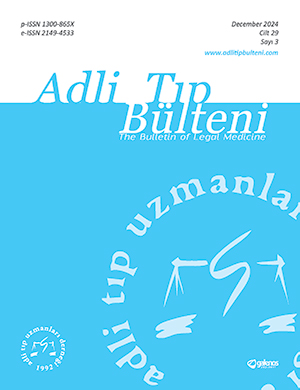An Analysis of Psychological Resilience and Secondary Trauma Among Psychologists Involved in the Earthquake Response in Kahramanmaraş
DOI:
https://doi.org/10.17986/blm.1726Keywords:
Mental Health Professionals, Psychological Resilience, Secondary Trauma, Secondary Traumatic Stress, EarthquakeAbstract
Objective: The aim of this study is to examine the relationship between the psychological resilience levels and secondary trauma levels of mental health professionals who were involved in the Kahramanmaraş-centered earthquake on February 6. Additionally, the study investigates whether psychological resilience and secondary trauma levels vary based on demographic factors.
Methods: Psychological resilience has been shown to negatively predict secondary traumatic stress (β=-0.412; t=-5.034; p<0.001). It was found that having experience in similar roles and exposure to short-term traumatic events may increase psychological resilience, while working with trauma victims for extended periods may increase the risk of secondary traumatic stress
Results: The findings revealed that psychological resilience negatively predicted secondary traumatic stress. Moreover, significant differences were found in the levels of psychological resilience and secondary traumatic stress according to various demographic variables. It was found that having prior experience in similar roles and being exposed to short-term traumatic events could enhance psychological resilience, while prolonged work with trauma victims could increase the risk of secondary traumatic stress.
Conclusion: In conclusion, it is recommended to develop training programs and intervention strategies to enhance the psychological resilience of professionals working in disaster and trauma fields, as well as to establish institutional policies and support systems to prevent and manage secondary traumatic stress.
Downloads
References
Batan S. N. Yetişkinlerde Psikolojik Dayanıklılık ve Dini Başa Çıkmanın Yaşam Doyumuna Etkileri. [Doktora Tezi]. Marmara Üniversitesi Sosyal Bilimler Enstitüsü. İstanbul, 2016.
Gürgan U. Grupla Psikolojik Danışmanın Üniversite Öğrencilerinin Yılmazlık Düzeyine Etkisi. [Yayınlanmamış Doktora Tezi], Ankara Üniversitesi Eğitim Bilimleri Enstitüsü. Ankara, 2006.
Figley C. R. Compassion fatigue: Toward a new understanding of the costs of caring. In B. H. Stamm (Ed.), Secondary traumatic stress: Self-care issues for clinicians, researchers, and educators .The Sidran Press, 1995:2-28.
Neria Y, Nandi A, ve Galea S. Post-traumatic stress disorder following disasters: A systematic review. Psychological Medicine,2008:38(4), 467-480.
APA. Diagnostic and Statistical Manual of Mental Disorders, 5th ed. (DSM-5). Washington, DC, American Psychiatric Association, 2013.
Everly G. S, Barnett D. J. ve Links J. M. The Johns Hopkins model of psychological first aid (RAPID-PFA): Curriculum development and content validation. International Journal of Emergency Mental Health, 2012:14(2), 95-103.
Pearlman L. A, Saakvitne K. W. Trauma and the therapist: Countertransference and vicarious traumatization in psychotherapy with incest survivors. New York, NY: W. W. Norton & Company, 1995.
Bride B. E, Jones J. L. Secondary traumatic stress in child welfare workers: Exploring the role of supervisory relationships. Social Work, 2004:49(4), 529-540.
Meadors P, Lamson A, Swanson M, White, M, Sira, N. Secondary traumatization in pediatric healthcare providers: Compassion fatigue, burnout, and secondary traumatic stress. Omega: Journal of Death and Dying, 2010:60(2), 103-128.
Bonanno G. A. Loss, trauma, and human resilience: have we underestimated the human capacity to thrive after extremely aversive events?. The American Psychologist, 2004: (17) (17)59(1), 20–28. https://doi.org/10.1037/0003-066X.59.1.20
Ludick M, Figley C. R. Toward a mechanism for secondary trauma induction and reduction: Reimagining a theory of secondary traumatic stress. Traumatology. 2017:23(1), 112-123. https://doi.org/10.1037/trm0000096
Büyüköztürk Ş, Kılıç Çakmak E, Akgün Ö. E, Karadeniz Ş, Demirel F. Bilimsel araştırma yöntemleri (25. baskı). Pegem Akademi.2018.
Friborg O, Hjemdal O, Rosenvinge J. H, Martinussen M. A new rating scale for adult resilience: what are the central protective resources behind healthy adjustment?. International Journal of Methods in Psychiatric Research. 2003:12(2),65–76. https://doi.org/10.1002/mpr.143
Baird K, Kracen A. C. Vicarious traumatization and secondary traumatic stress: A research synthesis. Counselling Psychology Quarterly.2006:119(2), 181-188.
Burnett H. J, Wahl K. The compassion fatigue and resilience connection: A survey of resilience, compassion fatigue, burnout, and compassion satisfaction among trauma responders. International Journal of Emergency Mental Health and Human Resilience, 2015:17(1), 318-326.
Kulkarni O, Dahan M, Montreuil B.Resilient hyperconnected parcel delivery network design under disruption risks. International Journal of Production Economics, 251, 108499
Downloads
Published
Issue
Section
License
Copyright (c) 2025 The Bulletin of Legal Medicine

This work is licensed under a Creative Commons Attribution 4.0 International License.
The Journal and content of this website is licensed under the terms of the Creative Commons Attribution (CC BY) License. The Creative Commons Attribution License (CC BY) allows users to copy, distribute and transmit an article, adapt the article and make commercial use of the article. The CC BY license permits commercial and non-commercial re-use of an open access article, as long as the author is properly attributed.

